To Culiacán, in Shadows and Hope
Keywords:
Violence, Culiacán, Social denunciation, Reflective poetry, Artificial IntelligenceAbstract
An artificial intelligence was tasked with creating a poem dedicated to the inhabitants of Culiacán, based on a prompt addressing the population's suffering due to drug-related violence, while acknowledging a sector complicit in normalizing and glorifying this pseudo-culture over decades. Throughout the creative process, the author collaborated with the ChatGPT application to refine the composition, adjusting the verses to align with the proposed ideas. The author applied stylistic modifications and tailored the verses to the specific context, producing a text within the lyrical genre. The poem, marked by its reflective and critical tone, belongs to social poetry as it addresses themes of denunciation and societal transformation. It focuses on condemning violence and the glorification of drug trafficking in Culiacán, blending a tone of indignation with a call for self-criticism and hope. From a technical standpoint, the poem features predominantly hendecasyllabic metre (11 syllables), interspersed with decasyllables (10 syllables) and dodecasyllables (12 syllables). Key stylistic devices include metaphors, rhetorical questions, and apostrophes that directly address the city. Despite the absence of a rigid metrical scheme or uniform rhyme, the fluid rhythm and use of synalephas enhance its solemn and contemplative tone. Overall, the poem exemplifies contemporary poetry, inviting introspection and urging the rejection of violence's normalization while fostering a vision for social transformation.
Downloads
References
Adorno, T. W. (1970). Ästhetische Theorie (G. Adorno & R. Tiedemann, Eds.). Frankfurt a. M.: Suhrkamp Verlag.
(Ed. cast.: Adorno, T. W. (2004). Teoría estética (J. Navarro Pérez, Trad.). Madrid: Ediciones Akal).
Arendt, H. (2009). La condición humana (R. Gil Novales, Trad.). Paidós. (Obra original publicada en 1958).
Assmann, A. (2006). Der lange Schatten der Vergangenheit. Erinnerungskultur und Geschichtspolitik. Beck. “La larga sombra del pasado” Traducción disponible en: https://es.scribd.com/document/268135265/assmann-la-larga-sombra-delpasado-pdf
Autor desconocido. (2023, 12 de abril). Arte e inteligencia artificial: ¿El fin de la creatividad humana? Blog, ArtMadrid 25, sección Actualidad. Recuperado de https://www.art-madrid.com/es/post/arte-e-inteligencia-artificial-el-fin-de-la-creatividad-humana
Benjamin, W. (2002). La obra de arte en la era de su reproductibilidad técnica (J. Maiso Blasco & J. A. Zamora, Trad.). Editorial Akal. (Original publicado en 1935).
Bermúdez, D. (2018, abril 1). La abundancia de información digital genera desinformación. El Economista. Recuperado de https://www.eleconomista.com.mx/tecnologia/La-abundancia-de-informacion-digital-genera-desinformacion-20180401-0005
Galiana, Y. (2023, 30 de agosto). Poesía social: qué es y 4 poetas importantes. Divulgación. Recuperado de https://www.lecturalia.com/blog/2023/08/30/poesia-social-que-es-y-poetas-importantes/
Halbwachs, M. (1992). La memoria colectiva. Alianza Editorial.
Jiménez Ornelas, R., & Reyes García, D. (2017). Violencia social, algunas de sus manifestaciones: Delincuencia e inseguridad en México.
En G. Giménez & R. Jiménez (Coords.), La violencia en México a la luz de las ciencias sociales (pp. 59). México: Universidad Nacional Autónoma de México, Instituto de Investigaciones Sociales.
Mir, E. (2023). El cambio de paradigma de la Inteligencia Artificial: Hacia una creatividad asistida. EME Experimental Illustration, Art & Design, (11), 64–75. https://doi.org/10.4995/eme.2023.19249
OpenAI. (2023). ChatGPT prompt engineering. https://openai.com/blog/chatgpt-prompt-engineering

Downloads
Published
Issue
Section
Categories
License
Copyright (c) 2024 SIBIUAS Revista de la Dirección General de Bibliotecas

This work is licensed under a Creative Commons Attribution-NoDerivatives 4.0 International License.

